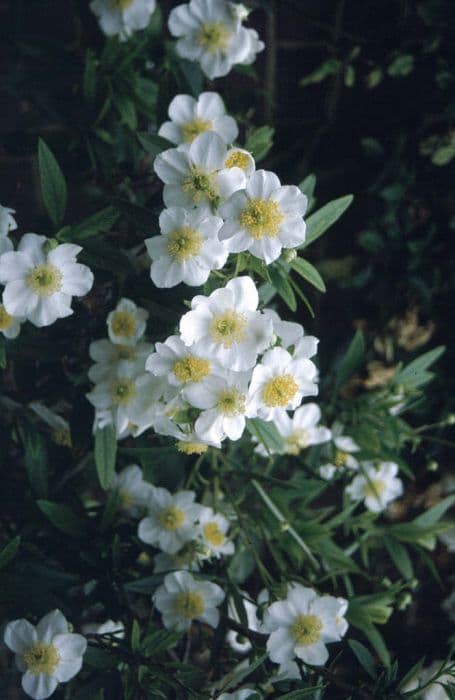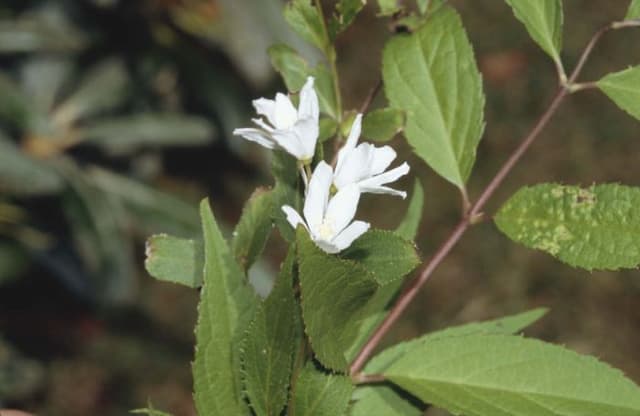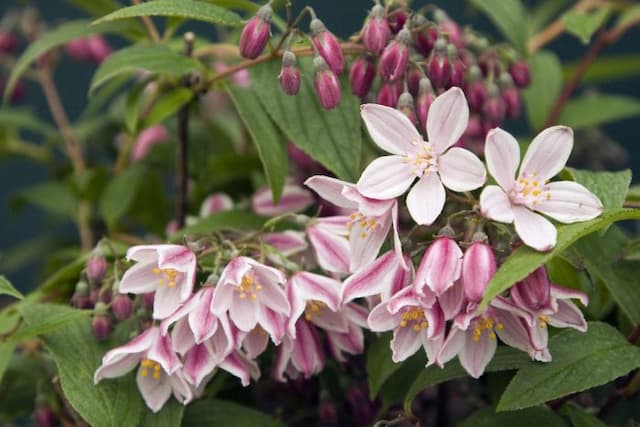Panicle Hydrangea Hydrangea paniculata

ABOUT
Hydrangea paniculata, commonly known as the panicled hydrangea, is a visually striking plant characterized by its lush foliage and large, conical flower clusters. The leaves of this hydrangea are ovate or heart-shaped, with a somewhat pointed tip and serrated edges, appearing in a deep green color that provides a vibrant backdrop for its blooms. The most distinguishing feature of the panicled hydrangea is its flowers, which form in pyramid-shaped panicles, a stark contrast to the round globes of some other hydrangea species. These panicles bloom profusely, beginning as a creamy white and often maturing to shades of pink or even a light burgundy as the season progresses. The flowers are a mixture of small fertile florets and showier, larger sterile florets, which together create a full, fluffy appearance that can be quite eye-catching in any garden setting. Moreover, the panicled hydrangea's blooms are known for their long-lasting nature and their ability to withstand the summer sun, making them highly valued for both fresh-cut floral arrangements and dried bouquets. The transition of colors throughout the blooming period adds an element of changing beauty to the plant, continuously transforming the appearance of the garden landscape within which the panicled hydrangea resides.
About this plant
 Names
NamesFamily
Hydrangeaceae.
Synonyms
Panicle Hydrangea, Peegee Hydrangea, Panicled Hydrangea, Limelight, Grandiflora.
Common names
Hydrangea bretschneideri, Hydrangea heteromalla.
 Toxicity
ToxicityTo humans
Hydrangea paniculata, commonly known as panicle hydrangea, contains toxic compounds which may have adverse effects if ingested. The plant has compounds called cyanogenic glycosides, which can release cyanide in the body when chewed or broken. Toxicity symptoms from ingesting parts of the panicle hydrangea may include stomach upset, vomiting, and diarrhea. In severe cases, ingestion could lead to more serious symptoms such as dizziness, labored breathing, or confusion owing to cyanide's ability to inhibit oxygen utilization by the cells.
To pets
Similar to its effects on humans, the panicle hydrangea is also toxic to pets, including dogs and cats. The plant contains cyanogenic glycosides which can release cyanide into the pet's system upon ingestion. Symptoms of poisoning in pets may include gastrointestinal distress, such as vomiting and diarrhea, lethargy, depression, and in severe cases, difficulty breathing or seizures due to the impact of cyanide on cellular oxygen. Prompt veterinary attention is advised if a pet has ingested any part of the plant.
 Characteristics
CharacteristicsLife cycle
Perennials
Foliage type
Deciduous
Color of leaves
Green
Flower color
White
Height
8-15 feet (2.4-4.6 meters)
Spread
6-10 feet (1.8-3 meters)
Plant type
Shrub
Hardiness zones
3-8
Native area
China Japan
Benefits
 General Benefits
General Benefits- Aesthetic appeal: Hydrangea paniculata, commonly known as panicle hydrangea, offers attractive and long-lasting flowers that enhance the visual appeal of gardens and landscapes.
- Variety of cultivars: There is a wide range of cultivars available, offering various sizes, flower colors, and shapes to suit different garden designs and preferences.
- Cold hardiness: Panicle hydrangea is known for its ability to withstand colder temperatures than many other hydrangea species, making it suitable for gardens in cooler climates.
- Tolerant of pruning: This plant responds well to pruning, allowing gardeners to maintain the desired shape and size or to rejuvenate older plants.
- Extended blooming period: Panicle hydrangea typically has a long blooming period from mid-summer to autumn, providing color when many other plants have finished flowering.
- Attracts pollinators: The flowers attract bees and butterflies, which are beneficial for pollination of gardens and ecosystems.
- Drought resistance: Once established, panicle hydrangea can be more drought-tolerant than other hydrangeas, reducing the need for frequent watering.
- Versatility in landscaping: Can be planted in a variety of settings, such as in borders, as specimen plants, or in mass plantings, providing versatility in landscape design.
- Relatively pest and disease resistant: Panicle hydrangea is generally resistant to many common pests and diseases that affect other garden plants.
 Medical Properties
Medical PropertiesThis plant is not used for medical purposes.
 Air-purifying Qualities
Air-purifying QualitiesThis plant is not specifically known for air purifying qualities.
 Other Uses
Other Uses- PeeGee hydrangea can be used for crafting and floral arrangements. The dried flower heads can be sprayed with metallic paint for a decorative touch in bouquets or centerpieces.
- The wood of PeeGee hydrangea is suitable for making small, carved objects due to its hardness and fine grain after complete drying.
- Its large, showy blossoms can be used as natural dyes for fabrics, yielding shades of blue, purple, or pink depending on the pH levels of the soil in which the plant was grown.
- Landscape gardening often uses PeeGee hydrangea for adding a structural element because the plant maintains a sturdy shape even when not in bloom.
- PeeGee hydrangea can be planted to create privacy screens or hedges, taking advantage of its dense foliage and height.
- The plant can be used in educational settings to teach about soil pH and its effect on flower coloration, as the blossoms change color correlating to the soil acidity.
- In photography, PeeGee hydrangea serves as a subject for macro photography, showcasing the intricate details of its large flower heads.
- The bark and leaves, when boiled, create a solution that can be used as a natural cleanser or for handwashing delicate fabrics.
- The large leaves can be used in nature crafts, such as leaf-printing art or paper-making workshops, due to their interesting texture and size.
- Gardeners use PeeGee hydrangea as companion plants to help highlight specific garden features or plants due to their eye-catching blooms.
Interesting Facts
 Feng Shui
Feng ShuiThe Hydrangea is not used in Feng Shui practice.
 Zodiac Sign Compitability
Zodiac Sign CompitabilityThe Hydrangea is not used in astrology practice.
 Plant Symbolism
Plant Symbolism- Gratitude and Apology: Hydrangeas often symbolize an expression of deep heartfelt gratitude for being understood, or as an apology for a wrong done.
- Heartlessness and Frigidity: In some cultures, hydrangeas are associated with negative sentiments such as heartlessness or frigidity, often due to their appearance of being lush but yielding little nectar for insects.
- Vanity: The lavish and showy blossoms of the hydrangea can sometimes represent vanity or boastfulness.
- Pride: With its abundant and extravagant flower heads, hydrangeas can also stand for pride and boastfulness, reflecting their full and rounded shape.
- Understanding: A common symbolism attached to hydrangeas is understanding, likely linked to their common use in fourth wedding anniversaries where the emphasis is on the deepening levels of comprehension between partners in a marriage.
- Abundance and Prosperity: The hydrangea's generous clusters of flowers can signify abundance and prosperity, relating to their full and bountiful appearance.
 Water
WaterPanicled hydrangeas should be watered deeply and thoroughly to ensure the root zone is adequately moistened; this typically means applying about 1 inch of water per week, either through rainfall or manual watering. During hot or dry periods, increase the amount to 2 inches per week. The soil should be kept moist but not waterlogged, and it’s important to avoid overhead watering to prevent leaf diseases. It’s best to water these hydrangeas in the morning so excess water on the leaves can evaporate during the day. During the winter, reduce watering significantly, but do not allow the roots to dry out completely.
 Light
LightPanicled hydrangeas thrive best in full sun to partial shade, with at least four hours of direct, unfiltered sunlight each day. They can tolerate full sun in cooler climates, but in warmer regions, they benefit from some afternoon shade to prevent stress from excessive heat. Ideally, plant them in a spot that receives morning sunlight and partial afternoon shade to protect them from the intense heat of the day.
 Temperature
TemperaturePanicled hydrangeas are hardy plants that can tolerate a wide range of temperatures, surviving minimum temperatures down to around -30°F. They grow best in an environment where the average temperatures range between 65°F and 75°F during the growing season. Extreme heat above 95°F might stress the plants, especially if they are not adequately watered and shaded during the hottest part of the day.
 Pruning
PruningPanicled hydrangeas benefit from annual pruning to maintain shape, encourage robust growth, and enhance blooming. Pruning should be done in late winter or early spring before new growth starts. Remove dead or weak stems and cut back about one-third of the oldest stems to the base to encourage new growth and flower buds. The best time for pruning is before the growing season begins, as panicled hydrangeas bloom on new wood.
 Cleaning
CleaningAs needed
 Soil
SoilThe best soil mix for Peegee hydrangea should be rich, moist, and well-draining, with a pH of 5.5 to 6.5. An ideal mix would include garden soil, compost, and peat moss to aid moisture retention and ensure nutrients are readily available.
 Repotting
RepottingPeegee hydrangeas generally do not need frequent repotting; it is typically only necessary every 3 to 5 years unless the plant outgrows its pot or the soil becomes exhausted.
 Humidity & Misting
Humidity & MistingPeegee hydrangeas thrive in average outdoor humidity levels; they do not require special humidity conditions when planted in the garden.
 Suitable locations
Suitable locationsIndoor
Place in bright, indirect light, and keep soil evenly moist.
Outdoor
Plant in partial shade to full sun, and mulch to retain moisture.
Hardiness zone
3-8 USDA
 Life cycle
Life cycleHydrangea paniculata, commonly known as the panicle hydrangea, starts its life cycle as a seed that germinates in moist, well-drained soil in early spring. After germination, the seedling grows into a young plant with a main stem and several leaves, entering the vegetative stage. As the hydrangea matures, it develops a woody stem and branches, eventually forming a shrub-like structure. Flower buds form at the tips of the branches in the second year of growth, typically blooming during the summer months; the flowers are white, later turning shades of pink or red as they age. Following pollination, the flowers produce small capsules containing seeds, which are dispersed in autumn. The hydrangea enters a period of dormancy during the winter, with the cycle beginning anew the following spring.
 Propogation
PropogationPropogation time
Late winter to early spring
For the Hydrangea paniculata, commonly known as the panicle hydrangea, the most popular method of propagation is via softwood cuttings. This technique is usually carried out during late spring or early summer when the new growth is still supple and has not yet hardened. Gardeners select healthy, non-flowering shoots and cut a 4-6 inch (10-15 cm) portion from the tip, making the cut just below a node. It is important to remove the leaves from the lower half of the cutting to reduce moisture loss. The cut end is then dipped into a rooting hormone and placed in a light soil mix or perlite. To create a humid environment, the cutting can be covered with a plastic bag or placed in a propagator. The cuttings typically root within 4 to 8 weeks, after which they can be transplanted to a more permanent location.








![Hydrangea [Strong Annabelle]](/_next/image?url=https%3A%2F%2Fplants-admin.emdemapps.com%2Fimages%2Fplants%2F%2Fimages%2F604b54db37d34.png&w=640&q=75)
